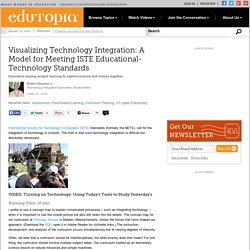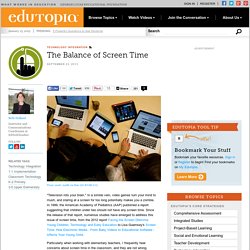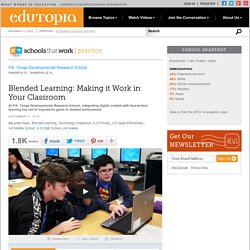

Visualizing Technology Integration: A Model for Meeting ISTE Educational-Technology Standards. International Society for Technology in Education (ISTE) Standards (formerly the NETS), call for the integration of technology in schools.

The truth is that such technology integration is difficult but absolutely necessary. I prefer to use a concept map to explain complicated processes -- such as integrating technology -- when it is important to see the overall picture but also drill down into the details. The concept map for our curriculum at Ferryway School, in Malden, Massachusetts, shows the forces that have shaped our approach.
(Download the PDF; open it in Adobe Reader for clickable links.) The Balance of Screen Time. "Television rots your brain.

" In a similar vein, video games turn your mind to mush, and staring at a screen for too long potentially makes you a zombie. In 1999, the American Academy of Pediatrics (AAP) published a report suggesting that children under two should not have any screen time. Since the release of that report, numerous studies have emerged to address this issue of screen time, from the 2012 report Facing the Screen Dilemma: Young Children, Technology and Early Education to Lisa Guernsey's Screen Time: How Electronic Media - From Baby Videos to Educational Software - Affects Your Young Child. Particularly when working with elementary teachers, I frequently hear concerns about screen time in the classroom, and they are not wrong. Students should learn to interact in a face-to-face setting, experience the physical world and go outside.
Welcome to Our Virtual Worlds. Turning On the Lights. Stopping the silence: hearing parents' voices in an urban first-grade family literacy program. Blended Learning: Making it Work in Your Classroom. Kristin: I can say that the things I've been doing the last two years have really made a difference, because my kids have scored the highest in the State on the standardized tests.

So what we're doing here is working, and it's helping them be successful. Julie: We define Blended Learning as the combination of digital content and activity with face-to-face content and activity. Our Brains Extended. In the 21st-Century University, Let's Ban (Paper) Books. Mystery Rocks and Marvelous Machines.